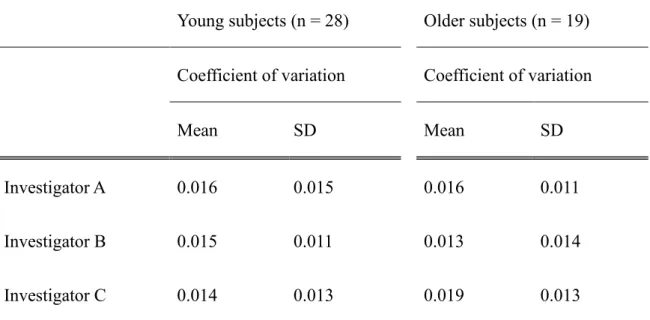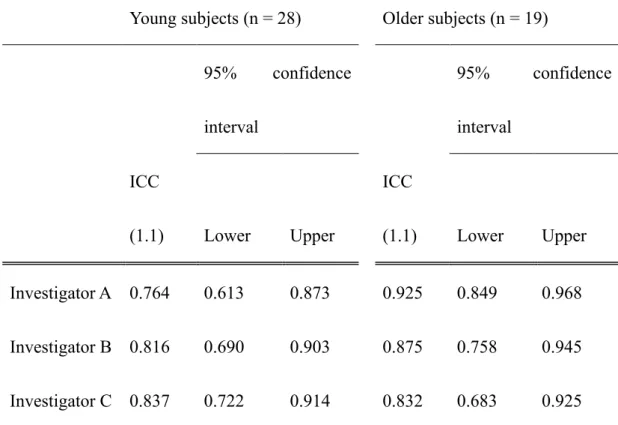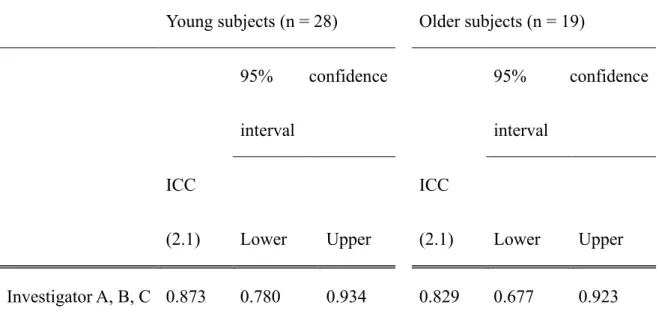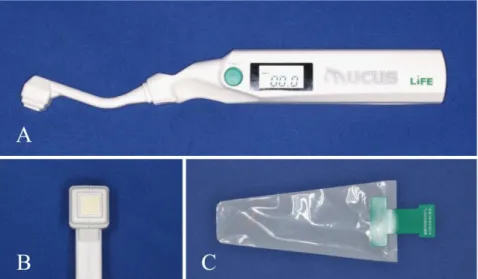Posted at the Institutional Resources for Unique Collection and Academic Archives at Tokyo Dental College, Available from http://ir.tdc.ac.jp/
Title
Intra- and inter-investigator reliabilities of oral moisture measured using an oral moisture-checking device
Author(s) Alternative
Takano, T; Kugimiya, Y; Morita, K; Tazawa, S; Ueda, T; Sakurai, K
Journal Journal of oral rehabilitation, 47(4): 480-484 URL http://hdl.handle.net/10130/5406
Right
This is the peer reviewed version of the following article: J Oral Rehabil. 2020 Apr;47(4):480-484, which has been published in final form at
https://doi.org/10.1111/joor.12919. This article may be used for non-commercial purposes in
accordance with Wiley Terms and Conditions for Use of Self-Archived Versions.
1
Intra- and inter-investigator reliabilities of oral moisture measured using an oral moisture-checking device
Running title: Reliability of moisture-checking device
Tomofumi Takano1, Yoshihiro Kugimiya1, Kuniko Morita1, Shiho Tazawa1, Takayuki
Ueda1, Kaoru Sakurai1
1Department of Removable Prosthodontics and Gerodontology, Tokyo Dental College,
Tokyo, Japan
Correspondence Dr. Takayuki Ueda
Department of Removable Prosthodontics & Gerodontology, Tokyo Dental College 2-9-18 Kanda-Misakicho Chiyoda city Tokyo, 101-0061, Japan
Tel: +81-3-6380-9201 E-mail: uedat@tdc.ac.jp
Acknowledgments None
2 Abstract
Background
Oral mucosal moisture determined using oral moisture-checking devices is used as a mouth dryness evaluation method. Such devices are capable of evaluating the state of mouth dryness in a simple manner and have applicability in a wide range of subjects; however, their intra- and inter-investigator reliabilities have not yet been clarified.
Objective
This study aims to investigate the intra- and inter-investigator reliabilities of measuring oral moisture using an oral moisture-checking device for a wide range of age groups.
Methods
Intra- and inter-investigator reliabilities were investigated in 28 young subjects and 19 older subjects aged ≥65 years. Three trained investigators independently
measured oral mucosal moisture values using an oral moisture-checking device. Intra-investigator reliability was assessed using the coefficient of variation (CV) and intraclass correlation coefficient (ICC) (1.1), and inter-investigator reliability was assessed using ICC (2.1).
3 Results
Mean CV was 0.015 and 0.016, mean ICC (1.1) was 0.806 and 0.877, and ICC (2.1) was 0.873 and 0.829 in the young and older subjects, respectively.
Conclusion
In young subjects, the mean values of ICC (1.1) and ICC (2.1) of the oral moisture-checking device were 0.806 and 0.873, respectively, whereas in older subjects, these values were 0.877 and 0.829, respectively. Thus, this confirms that the
examination of oral mucosal moisture using the oral moisture-checking device has sufficient intra- and inter-investigator reliabilities for a wide range of age groups.
Keywords: Mucous membrane, Mouth dryness, Clinical investigator, Reliability of results, Xerostomia, Evaluation methodology
4 INTRODUCTION
The concept of oral hypofunction has been proposed to evaluate multifaceted and diagnose decreased oral function.1 Mouth dryness is a diagnostic criterion of this
condition. Mouth dryness is assessed by the evaluation of oral mucosal moisture1–4;
saliva volume using the gum chewing test,5 paraffin chewing test,5,6 Saxon test,1,5
spitting method,3,5,7 or modified cotton roll method8 and the evaluation of the physical
properties of saliva. To diagnose oral hypofunction, mucosal moisture in the central region of the tongue dorsum is assessed using an oral moisture-checking device or by measuring the saliva volume using the Saxon test.1 Oral moisture-checking devices are
considered to be useful to evaluate mouth dryness because they allow the assessment of oral mucosal moisture without the influence of total saliva secretion volume.2,9,10 Saliva
volume measurement requires time and thus places a significant burden on patients. Furthermore, it is difficult to perform in patients with reduced cognitive function and high brain dysfunction. In contrast, saliva measurement using an oral moisture-checking device is completed within 2 s, has significantly fewer burdens on subjects, and is capable of evaluating oral mucosal moisture at rest without depending on the general condition or cooperativeness of subjects. Therefore, the use of these devices is appropriate for mouth dryness evaluation in older and disabled individuals.
5
Despite these advantages, values measured using an oral moisture-checking device has been reported to be influenced by contact pressure during the measurement.11
Therefore, investigating the intra- and inter-investigator reliabilities of measurements performed using oral moisture-checking devices is important to confirm the reliability of measured values. In this study, the intra- and inter-investigator reliabilities of oral moisture measured using an oral moisture-checking device were investigated to clarify this issue for a wide range of age groups. We hypothesized that the oral moisture-checking device has sufficient intra- and inter-investigator reliabilities.
METHODS Subjects
The present study was performed between October and December 2018. Study subjects consisted of 28 Tokyo Dental College students (15 males:13 females; mean age: 24.3 ± 2.9 years) and 19 patients aged ≥65 years (8 males:11 females; mean age: 73.6 ± 8.2 years) who visited the prosthetic dentistry Department of Tokyo Dental College Suidobashi Hospital. Patients with abnormal features, such as pain on the tongue, or experiencing discomfort from device touching the tongue were excluded from the study. Study objectives and methodology were orally explained to the subjects
6
using study documents and written informed consent to participate was retrieved from all. The study was approved by the ethics committee of Tokyo Dental College (approval no. 884).
Measurement method
Oral mucosal moisture was measured using an oral moisture-checking device (Mucus®, product number: 441244, Life Co., Ltd., Saitama, Japan) (Figure 1).
Following the method reported by Fukushima et al., the device was covered with a polyethylene disposable sensor cover exclusive to it, and mucosal moisture was measured in the central region of the tongue mucosa at 10 mm from the tongue tip.2,11
To appropriately measure oral mucosal moisture, the device was pressed to the tongue mucosa at 200 gf of pressure.11,12 Three dentists carefully read the manual of the device
and calibrated the technique of measurement with each other. Subsequently, they independently measured the oral mucosal moisture value three consecutive times for each subject, in a total of nine measures. The measurement interval among investigators was 15 seconds, with subjects closing their mouth during intervals. To standardize the measurement method, the three investigators trained separately as reported by Fukushima et al.2,11,12
7 Measurement conditions
Subjects closed their mouth 10 minutes before measurement and rested.11,13
During measurement, participants sat on a chair and followed two previously given instructions: to resist the force of the oral moisture-checking device pressing against their tongue and to keep their mouth open during the three consecutive measurements performed by each investigator. Subjects wearing complete dentures removed them during measurement. For subjects wearing removable partial dentures, the measurer confirmed denture stability and judged whether they should be removed during measurement.
Intra- and inter-investigator reliabilities
To investigate intra- and inter-investigator reliabilities, the oral mucosal moisture value was measured in young and older subjects. To investigate intra-investigator reliability, each of the three investigators measured the oral mucosal moisture value three times for each subject. For inter-investigator reliability assessment, investigators performed three measures for each subject, and the median of the three values was adopted.11 Inter-investigator reliability was investigated using representative
8
values measured by the three investigators. Retrieved values were not shared between investigators during measurement.
Statistical analysis
For reliability analysis, the coefficient of variation (CV) and intraclass correlation coefficient (ICC) were used. To assess intra-investigator reliability, CV and ICC (1.1) were calculated from the three values measured by each investigator. To assess inter-investigator reliability, ICC (2.1) was calculated from representative values measured by the three investigators. According to the method by Wolak et al., assuming a 95% confidence interval width of 0.3 and an ICC of 0.8, the required sample size was 17 people.14 Therefore, the number of subjects in this study was sufficient for both
young and older subjects.14 The significance level was set at 0.05. Statistical analysis
was performed using IMB SPSS Statistics 25 (IBM Corp., Armonk, NY, USA).
RESULTS
Mean ± standard deviation of the representative oral mucosal moisture values measured by the three investigators was 28.1 ± 1.4 and 29.7 ± 2.0 in the young and older subjects, respectively. CV of the three measurements performed by the three
9
investigators is shown in Table 1. Mean CV of the three investigators was 0.015 and 0.016 in the young and older subjects, respectively. ICC (1.1) of the three measurements for each investigator is shown in Table 2. Mean ICC (1.1) among the three investigators was 0.806 and 0.877 in the young and older subjects, respectively. ICC (2.1) of the median values measured by the three investigators is shown in Table 3. ICC (2.1) was 0.873 and 0.829 in the young and older subjects, respectively.
DISCUSSIONS
Oral moisture-checking devices employ the bioelectrical impedance method, which measures resistance from a very small electric current flowing into the sensor and calculates the water content at 50 μm under the mucosa. As this device does not measure the water content of the oral mucosal surface, but instead it measures the electrical charge proportional to the submucosal water content; measured values are unlikely to be influenced by drinking water or gargling before measurement. Moreover, during this process, electrical current flows through the shallow submucosal layer and not into the body, being safe and noninvasive to tissues.
In this study, the intra- and inter-investigator reliabilities of oral mucosal moisture values assessed using an oral moisture-checking device were investigated. To
10
confirm reliability for a wide range of ages, the assessment was performed in young and older subject groups. Intra-investigator reliability was evaluated based on CV and ICC (1.1) and inter-investigator reliability on the ICC (2.1). Mean CV determined from the CVs by three investigators was 0.015 in the young subjects and 0.016 in the older subjects. CV was very low in both the young and older subjects, highlighting that variation between repeated measurements within the same subjects is small in both the subject groups and that such measurements are reliable.
Mean ICC (1.1) representing intra-investigator reliability was 0.806 and 0.877 in the young and older subjects and ICC (2.1) representing inter-investigator reliability was 0.873 and 0.829 in the young and older subjects, respectively. Although no clear evaluation criterion exists for ICC values, following the evaluation criteria of Kappa coefficient used for similar purposes an ICC of 0.81 or higher is considered close to ideal.15 CV and ICC (2.1) of tongue pressure measurements used for diagnosing oral
hypofunction were 0.091 and 0.653, respectively,16 and ICC (2.1) of masticatory
function evaluation, which is also used to diagnose oral hypofunction, was 0.93,17
suggesting that the oral moisture-checking device is as reliable as other evaluation methods. In this study, ICC (1.1) and ICC (2.1) of measured oral mucosa moisture values were very high in both the young and older subjects. As the inter- and
11
intra-investigator reliabilities were both superior, the oral moisture-checking device may be applicable to a wide range of patients in different clinical settings and studies, with sufficient reliability.
The measurement method employed in this study was simple, which may justify the observed high reliability. The oral moisture-checking device is capable of measuring mucosal moisture by pressing the device vertically to the mucosal surface with appropriate force. The simplicity of the measurement method reduces measurement bias, potentially resulting in high reliability.
The following limitation needs to be considered. Values measured using an oral moisture-checking device reportedly varies because of the contact pressure on the oral mucosa.11 In the present study, investigators underwent proper measurement training
before the study and employed the standardized measurement method, which might explain the absence of large contact pressure-associated errors in the measured values. If an investigator who has little experience with oral moisture-checking device takes measurements, it may be possible for the contact pressure to vary and affect the measurements. Therefore, it is necessary to practice in advance when measuring oral moisture using an oral moisture-checking device.
12
measured by each investigator was adopted as representative for that investigator. Regarding the oral moisture-checking device, use of the three measurement median is recommended to offset the influence of random errors due to subject body movement and poor sensor contact.11 Measurement ICC (2.1) using an oral moisture meter was
very high, suggesting that both the oral moisture-checking device and the method measurement are sufficiently reliable, and adoption of the median value of three measurements is valid.
The oral moisture-checking device has already been reported to be useful in the evaluation of dry mouth.4,9,10,12 In the present study, we focused on the intra- and
inter-investigator reliabilities of the oral moisture-checking device. Overall, intra- and inter-investigator reliabilities of values measured using an oral moisture-checking device were confirmed in this study. This study is considered to be one of the evidences about the measurement method of dry mouth. The results of this study made it possible to compare different evaluation methods of oral moisture, such as the Saxon test, to further clarify the usefulness of the oral moisture-checking device. This measurement method may improve the accurate evaluation of oral moisture in oral function and xerostomia treatment studies in the future. As the measurement method is simple, dentists and dental hygienists with little experience may be able to use it after training.
13 CONCLUSIONS
In young subjects, the mean values of ICC (1.1) and ICC (2.1) of the oral moisture-checking device were 0.806 and 0.873, respectively, whereas in older subjects, the values were 0.877 and 0.829, respectively. Thus, the examination of oral mucosal moisture using the oral moisture-checking device is confirmed to have sufficient intra- and inter-investigator reliabilities for a wide range of age groups.
14
References
1. Minakuchi S, Tsuga K, Ikebe K, et al. Oral hypofunction in the older
population: Position paper of the Japanese Society of Gerodontology in 2016.
Gerodontology. 2018;35(4):317-324. doi:10.1111/ger.12347.
2. Fukushima Y, Yoda T, Araki R, et al. Evaluation of oral wetness using an
improved moisture-checking device for the diagnosis of dry mouth. Oral Sci Intl.
2017;14(2):33-36. doi:10.1016/S1348-8643(17)30017-4.
3. Okane M, Kitamura Y, Sato Y, Kitagawa N, Mashimo J. Objective assessment
of the subjective sensation of oral dryness. Ronen Shika Igaku. 2007;22(3):298-308.
doi:10.11259/jsg1987.22.298.
4. Fukushima Y, Sano Y, Isozaki Y, et al. A pilot clinical evaluation of oral
mucosal dryness in dehydrated patients using a moisture-checking device. Clin Exp
Dent Res. 2019;5(2):116-120. doi:10.1002/cre2.145.
5. Thomson WM. Issues in the epidemiological investigation of dry mouth.
Gerodontology. 2005;22(2):65-76. doi:10.1111/j.1741-2358.2005.00058.x.
6. Iwasaki M, Borgnakke WS, Yoshihara A, et al. Hyposalivation and 10-year
all-cause mortality in an elderly Japanese population. Gerodontology. 2018;35(2):87-94.
15
7. Ben-Aryeh H, Miron D, Berdicevsky I, Szargel R, Gutman D. Xerostomia in
the elderly: prevalence, diagnosis, complications and treatment. Gerodontology.
1985;4(2):77-82. doi:10.1111/j.1741-2358.1985.tb00373.x.
8. Ohara Y, Hirano H, Yoshida H, et al. Prevalence and factors associated with
xerostomia and hyposalivation among community-dwelling older people in Japan.
Gerodontology. 2016;33(1):20-27. doi:10.1111/ger.12101.
9. Satoh-Kuriwada S, Sasano T, Furuuchi T, Iikubo M, Sugawara Y, Shoji N.
Clinical evaluation of oral mucosal moisture in patients who complained of dry mouth.
J Jpn Soc Oral Mucous Membr. 2005;11(1):8-15. doi:10.6014/jjomm1995.11.8.
10. Tamaki S, Yamamoto K, Fukutsuji S, et al. Clinical evaluation of oral mucosal
moisture using moisture meter. J Jpn Stomatol Soc. 2007;56(2):234-240.
doi:10.11277/stomatology1952.56.234.
11. Fukushima Y, Kokabu S, Kanaya A, et al. Experimental Examination of
Appropriate Measurement Method of Oral Moisture Checking Device. J Jpn Soc Oral
Mucous Membr. 2007;13(1):16-25. doi:10.6014/jjomm1995.13.16.
12. Takahashi F, Koji T, Morita O. The usefulness of an oral moisture checking
device (moisture checker for mucus). Nihon Hotetsu Shika Gakkai Zasshi.
16
13. Fukushima Y, Yoda T, Araki R, et al. Experimental examination of temporal
variations of the moisture degree of the oral mucosa in ordinary persons. J Jpn Soc Oral
Mucous Membr. 2009;15(1):15-21. doi:10.6014/jjomm.15.15.
14. Wolak ME, Fairbairn DJ, Paulsen YR. Guidelines for estimating repeatability.
Methods Ecol Evol. 2012;3(1):129-137. doi: 10.1111/j.2041-210X.2011.00125.x
15. Landis JR, Koch GG. The measurement of observer agreement for categorical
data. Biometrics. 1977;33(1):159-174. doi:stable/2529310.
16. Ueda T, Oki T, Ohta M, Ogami K, Sakurai K. Intra- and inter-investigator
reliability of measurement of lip-seal strength in adults. Bull Tokyo Dent Coll.
2019;60(2):81-88. doi:10.2209/tdcpublication.2018-0038.
17. Igarashi K, Watanabe Y, Kugimiya Y, et al. Validity of a visual scoring
method using gummy jelly for evaluating chewing efficiency in a large-scale
17
Table 1. Coefficient of variation of measurements performed by three investigators to evaluate intra-investigator agreement
Young subjects (n = 28) Older subjects (n = 19) Coefficient of variation Coefficient of variation
Mean SD Mean SD
Investigator A 0.016 0.015 0.016 0.011
Investigator B 0.015 0.011 0.013 0.014
Investigator C 0.014 0.013 0.019 0.013
18
Table 2. Intraclass correlation coefficient (ICC) (1.1) of measurements performed by three investigators to evaluate intra-investigator agreement
Young subjects (n = 28) Older subjects (n = 19)
95% confidence interval 95% confidence interval ICC (1.1) Lower Upper ICC (1.1) Lower Upper Investigator A 0.764 0.613 0.873 0.925 0.849 0.968 Investigator B 0.816 0.690 0.903 0.875 0.758 0.945 Investigator C 0.837 0.722 0.914 0.832 0.683 0.925
19
Table 3. Intraclass correlation coefficient (ICC) (2.1) of median measurement values obtained by three investigators to evaluate inter-investigator agreement
Young subjects (n = 28) Older subjects (n = 19)
95% confidence interval 95% confidence interval ICC (2.1) Lower Upper ICC (2.1) Lower Upper Investigator A, B, C 0.873 0.780 0.934 0.829 0.677 0.923
20 Figure Legend
Figure 1. Oral moisture-checking device



